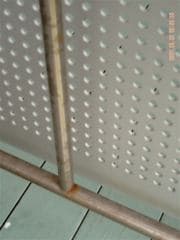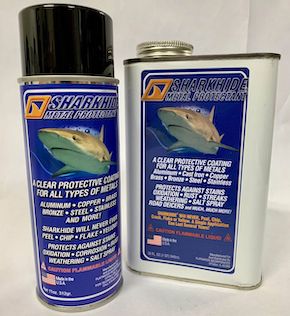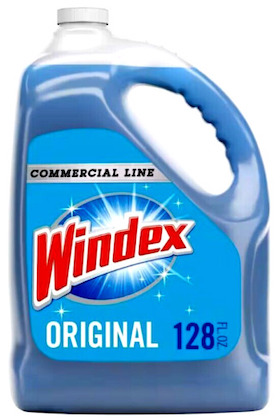
-----
Stainless steel with significant rust staining after 6 weeks
Q. We have just installed an external stair to our home 6 weeks ago. We have had a lot of wind and rain with sea spray and high humidity recently and are located right on the coast. The stainless steel posts and components show A LOT of rust staining in this short period of time, very unsightly and cannot be removed by simply washing down with detergent and a stiff nylon brush. It appears that a rust converter
⇦ on
eBay
or
Amazon [affil link]
or a sandpaper will be necessary to remove the staining.(like tea coloured splotches all over) We are surprised at the level of visual deterioration in such as short time and question whether we were supplied 316 grade at all. Do you think it is likely that we have 304 instead of 316 for the speed and extent of rust staining? or would this be expected?

Thank you
home renovator - Noosa, Qld, Australia
February 5, 2008
A. It would be unusual for 316 stainless steel to tea stain that quickly in a salt spray environment. 304 definitely would.
There are ways to clean it up easily, and help to keep it from coming back too quickly, but if it is 304SS it will always come back in a salt mist environment.
adv.
Contact us if you are interested in talking about how to clean it up.

Lee Kremer
Stellar Solutions, Inc.
McHenry, Illinois

February 13, 2008
Q. We manufacture SS pedestals for helm chairs and table pedestals that are used in the yachting industry and we use 304 grade; however it is polished to a mirror finish and does not discolor over time. perhaps you could look into that.
HB
- Savannah, Georgia
February 18, 2008
Hi Loretta,
I work with a couple of companies (one in the states, and one in the Cayman Islands) that make 316 S/S railings and steps used in coastal areas. They've had the same rust problems that you're having.
adv.
They now coat their railings and such with Sharkhide ⇨
to prevent any rust. A coat will typically protect for several years.
Good luck with your project,
O'Fallon, Illinois
A. The parts may not have been passivated or (definitely not electropolished as evident in the pictures) as the last step in manufacturing.
304 and 316 CAN corrode due to surface contaminants and a compromised passive layer. 304 more so than 316.
These contaminates come standard on the surface as a result of forming, drilling, cutting, welding, handling, sanding and improper cleaning. They will cause certain types of corrosion if not removed.
304 will corrode faster in salt water environments compared to 316.
At the very least have the parts passivated to remove rust and help limit further rusting or at least prolong the finish.
Electropolishing is superior form of passivation and works on 304 and 316. This will also remove rust and greatly increases the corrosion resistance. Based on your description and pictures electropolished 316 should not have corroded.
Never use steel wool to or hydrochloric/muriatic acid containing (concrete cleaner) to clean!
All that is needed to clean an electropolished finish is soap water or Windex Commercial Line ⇨
and a sponge or soft cloth.
electropolishing shop - North Vancouver, British Columbia, Canada
Q. Dear , I very interested in surface preparation and painting job. On now, my responsibility is co-ordinator on this job. May I know that how to clean stainless surface when corrosion is there? Thanks a lot
Kyaw Ya- Singapore
April 16, 2010
Rust on 304SS in Water Treatment Plant
Q. I work at a water treatment works and the 304SS has stained (brown marks) on the external to the pipes. There is a chance that gassing off of sodium hypochlorite in the air from some tanks could this be the cause and what would be the best way to clean?
Stewart Smolarek- Glasgow, Strathclyde, UK
April 12, 2018
A. Certainly hypochlorite can be the cause. The remedy is more difficult. I'd try a 25% solution of phosphoric acid to remove the brown stain, but it may be an ongoing problem. Can you provide some additional ventilation?

Jeffrey Holmes, CEF
Spartanburg, South Carolina
A. Unfortunately, once your stainless has gotten to the point where it's showing evidence of chemical attack like that, it's lost its passive layer and will no doubt discolor again.

Rachel Mackintosh
Lab Rat / WWTF - Greenfield MA
A. I sell a lot of rust removal/passivation products into water treatment plants, so it's definitely a common issue. As with all stainless in corrosive environments, it becomes a matter of regular maintenance.

Ray Kremer
Stellar Solutions, Inc.
McHenry, Illinois

this text gets replaced with bannerText

Q, A, or Comment on THIS thread -or- Start a NEW Thread

